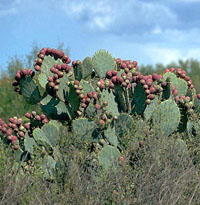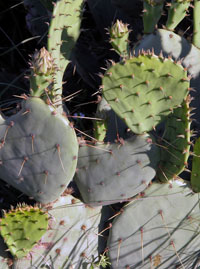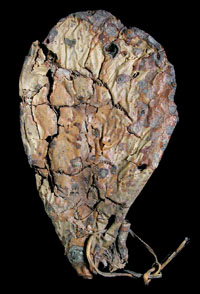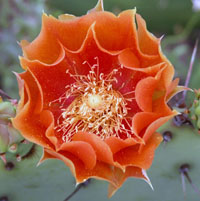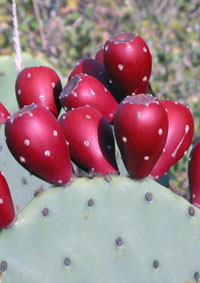Prickly Pear [Opuntia spp.]
Although this widespread cactus is often considered a nuisance today, it was a critical natural resource for native peoples in the Plateaus and Canyonlands, serving as a year-round mainstay food resource, a medicinal plant, an essential earth-oven layer, and even as a container and floor covering in dusty caves. Prickly pear gets its name from its sharp spines and is seasonal fruits known as pears or tunas. The long, sharp spines (the prickly part of the name) are actually modified leaves that harden as they age. Technically, the plant’s “branches,” known as pads or nopales, are succulent, evergreen stem segments. The fruit begins to ripen in midsummer to a deep red color and produces a very sweet, yet otherwise tasteless, purple-red juice. The tunas are harvested by many animals as well as people.
Prickly pear was a major resource for native peoples and its importance to prehistoric life throughout the Plateaus and Canyonlands region and far beyond is often underappreciated. While it is widely known that the pears were mainstay seasonal resource from mid-summer to early fall, the plant was used in many other ways. The pads, when backed and removed of their spines, can be eaten year round – direct evidence from Hinds Cave coprolites (dried human feces) suggests that the pads themselves were a mainstay food. The pads were also critical components of earth oven cooking—they were used as green packing material providing steamy moisture and chemical compounds that helped bake lechuguilla and sotol. The pads could also be used as containers and even canteens. Prickly pear can also be used for many different medicinal purposes including treating burns, wounds, and diabetes. All in all, prickly pear ranks up there with lechuguilla as a critical natural resource, but it occurs naturally throughout the region.
Details
The most common species of prickly pear is Opuntia engelmannii, which can grow into dense, shrubby clumps covering large tracts of land. This species and several close relatives favor well-drained rocky flats and slopes, but can grow practically anywhere. Livestock overgrazing, soil erosion, the cessation of range fires, and modern land clearing practices have caused prickly pear to spread widely and densely in areas that were once grassland savannas. In contrast to most types of cactus, prickly pear grows relatively quickly with adequate moisture and spreads easily; broken off stem segments readily take root and create whole plants.
Tunas
Each prickly pear fruit contains about 50 seeds, and it is the hard and durable seed that is found at many archeological sites. It not only survives the fruit processing activities, but passes through the human gut unscathed. At Hinds Cave, prickly pear seed was present in some deposits at densities exceeding 90 seeds/liter, a strong indication that prickly pear fruit was one of the most common plant foods for the people who lived along the lower Pecos River. We also have more direct evidence that prickly pear was consumed in large quantities by the Hinds Cave inhabitants, because the seeds or fragments of the seeds were found in 74% of the coprolites (desiccated human feces) in one study, and 82% of the coprolites in another study!
Tunas are harvested by knocking or twisting the fruits off the pads into a basket. The stiff hairs that cover the fruits need to be removed before they are consumed, and this can be accomplished by parching the fruit in hot coals or rubbing off the hairs using a rock. The fruits can be eaten raw, or they can be pounded in a mortar and pestle. A wooden mortar and pestle discovered in a cave in northern Val Verde County had prickly pear seeds in the cracks (Collins and Hester 1968). These seeds were probably wedged into the cracks when the user was pounding prickly pear fruits into juice and pulp. The juice is separated and consumed, and the remaining pulp can be sun-dried and stored.
Some early explorers learned the hard way that prickly pear tunas have to be processed carefully. The following advice is based on a historic prickly pear accident that occurred on Matagorda Island, as related by Henri Joutel, a survivor of La Salle’s expedition to Texas in the late 17 th century:
One must strip the fruit before eating it because, although the quills are quite small and almost imperceptible, without fail they make one sick once they lodge in the throat and on the roof of the mouth. One of our soldiers even died from having eaten the fig greedily without wiping it. All these quills caused tremendous inflammation of the throat and eventually suffocated him. (Foster 1998:124)
Nopales
Prickly pear pads (green fleshy stems) were edible, and even used as containers. Both the immature pads (nopalitos) and the mature pads (nopales) were consumed by the foragers of the past. Although the immature pad can be eaten raw, the mature pad most likely was baked first.
The most compelling archeological evidence that nopales were a dietary mainstay come from work at Hinds Cave. Fragments of the epidermis, or the outer skin, of the nopal, were identified in between 8% and 28% of the coprolites in one study, and 70% of the coprolites in another study from Hinds Cave (Stock 1983:65). Most of the Hinds Cave coprolites are also full of fibers, many of which may well be from nopales, but dietary fibers are so not easy to distinguish
Although it is 55-85% water by weight , prickly pear fruit is rich in Vitamin C and calcium and is a good source of carbohydrates. The pads contain fewer carbohydrates but are rich in Vitamin A. Mature pads probably were baked in an earth oven before consumption, because they contain oxalic acid and calcium oxalate crystals. The grinding effect of calcium oxalate crystals have been implicated in the poor dentition of the Lower Pecos peoples. On the other hand, the immature pads or nopalitos can be consumed raw, and are rich in calcium and digestible fibers.
Warning: Please be aware of the fact that the immature pads of wild prickly pear cactus can have very small spines that cause inflammation of the tongue and throat. These must be removed carefully. It is smarter to buy the spineless, cultivated variety at the grocery store. Nopalitos are available in the fresh fruits and vegetables section of most grocery stores. These cultivated nopalitos are grown from a spineless prickly pear variety originally developed by the famous plant breeder Luther Burbank.
Native Accounts
There are very few ethnohistoric accounts of the native use of prickly pear from Texas. The most famous is the great prickly pear harvest recorded by Cabeza de Vaca, the first European to cross Texas and write a first-hand report. In midsummer many different groups would converge on the area in southern Texas near Alice, Texas where prickly pear was ripening, and this was their favorite time of the year. They would squeeze the juice out of the fruit and dry the pulp and skin (Cabeza de Vaca 1983:80).
Some of the more detailed ethnographic records of pear processing come from groups in the western U.S. that did not rely on the plant as a major food source, only as a seasonal supplement. Typical preparation of the fruit includes drying and pressing fruits in to a large flatcake, as done by the Yavapai. There are examples of the fruit being pit-baked, as is reported for the Cahuilla. The Cahuilla pick the fleshy young fruit of Opuntia basilaris in early summer and steam or bake it (Bean and Saubel 1972). Opuntia engelmannii fruit is very juicy and needs only to be pounded and sun-dried. Although there are no ethnographic references to pit-baking green or partially ripened Opuntia engelmannii, Phil Dering has pit-baked the green or partially fruit and found it to be palatable.
Medicinal Uses
Prickly pear pads are also have very useful medicinal applications, and the dietary value of the immature pads, or nopalitos, is extremely important today for combating Type 2 (adult onset) diabetes. Here are some of the documented historic and modern uses of nopales.
- Infusion of pads used to treat urinary tract infections
- Mucilage (pulp) in raw nopalitos reduces rate of sugar absorption, hence they are effectively reduce symptoms of insulin shock
- Mature pads as poultice and antiseptic for wounds
- Mature pads to treat burns
- Tea made from pads for treating tuberculosis scar tissue
- Mucilage from mature pads kills bacteria in cultures, so it has antibiotic properties
- Hot poultice of prickly pear pad skin applied to boils
- Split pads used as a hemostat to stop bleeding
- Infusion of pads used to treat swollen prostate
- Pads are high in calcium, both insoluble calcium oxalate and soluble mucilage. They have a hypoglycemic effect, significantly lowering cholesterol and preventing glycemia. Soluble fibers, including viscous mucilage, inhibit the absorption of simple carbohydrates. Pads also contain high levels of amylose, a starch that breaks down into simple sugars more slowly than amylopectin, the starch in bread and potatoes. Mature pads, however, contain calcium oxalate crystals that are insoluble and may cause health problems.
- According to Laredo herbalist Tony Ramirez, nopales are useful in " preventing diet-related cardiovascular disease and adult onset diabetes" as well as protecting the male prostate gland. (Fowler 2001)
References
Bean, L., and K. Saubel
1972 Temalpakh: Cahuilla Indian Knowledge
and Usage of Plants .
Malki Museum Press.
Cabeza de Vaca, Alvar Nunez
1983 Adventures in the Unknown Interior
of America , translated
and edited by Cyclone Covey. University of New Mexico Press. [reprint of
1961 edition published by Crowell-Collier Publishing].
Collins, Michael B. and Thomas R. Hester
1968 A Wooden Mortar and Pestle
From Val Verde County, Texas. Texas Archeological
Society 39:1-8.
Fowler, Gene
2001 Rattler Oil, Mesquite Beans and Prickly Pear: Medicine
from Nature's Pharmacy. Texas Co-Op Power, September.
Stock, Janet A.
1983 The Prehistoric Diet of Hinds Cave. Department
of Anthropology, Texas A&M University, College Station.
William C. Foster, ed.
1998 La Salle Expedition to Texas: The Journal
of Henri Joutel, 1684-1687.
Texas State Historical Association, Austin.
Hide Details
![]()
